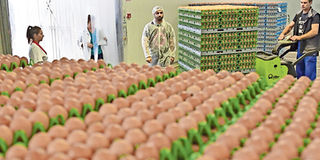Diary of a poultry farmer: Why some chicks die within the first two weeks

Processing and packing chicken eggs in a facility in Romania. Feeds alone account for up to 70 per cent of production costs in poultry. PHOTO | AFP
What you need to know:
- ome factors to consider when sourcing chicks include asking if the hatchery has a comprehensive history of vaccination and health management for breeding stock, looking at the chicks if they are clean, dry and free from dirt and contamination, with clear, bright eyes and checking whether they are active and alert.
- A poultry house should provide the birds with a comfortable environment and protect them from weather extremities like rain, wind or sunshine.
- Feeds alone account for up to 70 per cent of production costs in poultry.
Jerita is worried that her chicks die soon after hatching. Duncan is seeking advice to put up a poultry house and Stephen is struggling with high cost of feeds and persistent drought. The farmers say they need urgent intervention.
Here are my answers to their questions.
I keep Kienyeji chickens, but the hens hatch chicks that then die, mostly after a week or so.
Jerita Mwatha
From my experience, mortality in chicks during the first two weeks of life is often associated with the quality of hatched chicks.
This, in turn, depends on the quality of the breeding stock used (vaccination and health) and management practices at the hatchery.
In your case, besides proper brooding techniques, you could be dealing with stocks that have been in-bred for generations resulting in low stock production and high susceptibility to diseases.
Some factors to consider when sourcing chicks include asking if the hatchery has a comprehensive history of vaccination and health management for breeding stock, looking at the chicks if they are clean, dry and free from dirt and contamination, with clear, bright eyes and checking whether they are active and alert.
****
I have been following your articles, and I want to start rearing Kienyeji chickens on my quarter acre in Busia. Provide information on house designs and management up to point of lay.
Duncan Juma, Mombasa
A poultry house should provide the birds with a comfortable environment and protect them from weather extremities like rain, wind or sunshine.
For layers and Kienyeji, ensure two square feet per birds (six birds per square metre) and for broilers, ensure one square foot per bird.
Second, ensure the width doesn’t exceed 25 feet. A longer width impedes ability to expel harmful gases, reduces air quality and ability to control temperatures inside.
Third, leave one side of the house half-way open and covered with a wire mesh of small gauge and a net to prevent entry of wild birds, dogs and rodent.
****
I rear chicken and use commercial feeds which are expensive. My challenge is where to get affordable feeds with the persistent drought.
Aminy Stephen, Turkana
Feeds alone account for up to 70 per cent of production costs in poultry. I normally advise farmers rearing dual-purpose birds to free-range them to reduce cost of feeds although I don’t consider this a viable option for you.
Second, you could formulate your own feeds, but then, Turkana being a drought-stricken area, sourcing for raw materials from far is expensive.
Considering that you’d have to transfer the production costs to consumers, I just can’t think of a business model for rearing chickens in your circumstances, unless you’re doing it on a very large scale to maximise on economies of scale production.
However, entrepreneurs don’t look at the most immediate problem; they instead work to solve problems that seem insurmountable.





